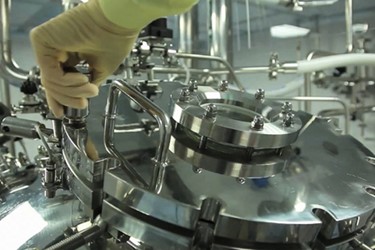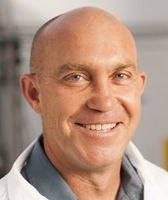No Freeze In Lyophilization Outsourcing

By Louis Garguilo, Chief Editor, Outsourced Pharma

Ionis Pharmaceuticals considers itself a research and development engine – and why wouldn’t it, with three successful commercial drugs to date and a pipeline of 40-plus clinic-worthy drug candidates.
What that means regarding the manufacture of the company’s drugs and pipeline, according to Max Moore, Executive Director, Manufacturing & Operations, is Ionis focuses on the manufacturing science, analytics, supply chain, and innovation associated with its platform technology, called antisense.

“We don't want to be a large-scale commercial manufacturer,” he explains. “What we've done is help set up operations at our partners. We work with all the CMOs out there in the world that can produce oligonucleotide API’s using our technology.”
As we learned in part one of our discussion, the lion’s share of that requires lyophilization.
And so might your future products.
More Lyo On The Way
The three compounds to date developed and commercialized by Ionis have been partnered, and as such, says Moore: “We want those partners to be able to have the compounds made at outsourcing service providers.” Ionis typically works CDMOs on behalf of itself and those partners, particularly on tech transfers.
“If you think about what we're doing, and that we began 30 years ago, there were no suppliers of the starting materials we needed, or the other specialty chemicals used to manufacture our drugs. Add to that we were constantly innovating,” says Moore.
“For example, because our drugs are synthetic RNA or DNA, we would obtain the individual bases – adenine, thymine, guanine and cytosine – via digestion of salmon milt. Can you imagine sitting around the office hoping the salmon catch was good each year? And wondering how we’d meet the projected commercial demands for our drugs if we were still relying on salmon milt? We had to develop chemical processes to produce those amidites. A lot of that research work was done at CMO’s with expertise in specific chemical reactions.”
When working with Ionis, CMOs can expect: weekly conference calls, close review of data in real time, the reception of lots of advice, and even, in some cases, taking samples back and doing our own analyses.
“It's intense,” says Moore of the relationships. “The CMOs that produce API come to us for training on the analytics, and we bring them into our manufacturing plant to witness our processes. We have ‘open sourcing’ to our partners and CMOs for all our internal reports. It's an active interaction. I don't want to use the word micromanaged, but it is intensely managed.”
Particularly in regards to the lyophilization and other technological requirements, how does Moore select the right CMO partners to start?
“First of all, you look for how committed they are as a business to your project?” he replies. “You look at their business platform. In other words, you almost want to start with a paper exercise.
“What is their business model? Does it make sense that they want to go deeper into this technology and relationship with us? How many years have they been doing it? What is the commitment from their upper management or investors? Do they have the expertise and can they be taught? So you start with an in-cerebral exercise to look at that information.
“Then you run the qualitative assessments. But we need to understand how passionate are they about this? Do they have scientists who care?”
And one more thing: “In most cases, we won't work with a CDMO until it has the analytics in place. There’s no need of jumping into a lab and starting to work on the chemistry if a CDMO’s analyses isn’t going to be tell us what we need to know.”
Freeze Dryers And Single-Use Trays
With the continuing growth in aseptic manufacturing and sterile fill-finish needs, lyophilization in its different categories and uses are on the upswing.
According to an entry earlier this year in The Particle Science Blog:
“As complex drug products and large molecule formulations become more common, an increasing number of pharmaceutical formulations face stability issues in solution, and a ready-to-use liquid dosage form is not possible. To solve this issue, many parenteral drug products undergo sterile lyophilization (i.e., freeze-drying) to generate a stable powder for storage and transport. This is not a new process, and multiple blockbuster drugs (including biologics such as Enbrel, Herceptin, and Rituxan) are possible due to sterile lyophilization. From 2013-2015, half of all new injectable/infusible drug approvals were lyophilized, and market projections estimate this growth will continue in the future.”
In part one, when I asked Moore what he sees as important technologic gains in the science and application of lyo to assist in that future, he pointed me at Gore BioPharma Products’ “single-use” lyophilization trays.
Most interesting in that reply is those single-use trays have been around for 20 years or so.

“The biopharmaceutical industry was already embracing single-use 20 years ago,” Ross told me. “Single-use started as a trend probably in the mid-nineties, although it took longer to spill over into small molecule. We were ahead of our time. Now we're seeing this phenomenal growth with polypeptide and all of the nucleotide drugs. There’s a renewed focus on being able to eliminate tray cleaning and cleaning validation, and optimize freeze drying. And of course better protecting operators.”
He continues: “We see this growth in polypeptide and oligonucleotide drugs because those are typically lyophilized in bulk. But certainly for others involved in bio-lyophilization or syringe lyophilization, the biotherapeutic proteins and monoclonal antibodies are classes of drugs that are also growing.
“All these drugs are comparatively unstable in the liquid form to get them into a solid cake. I think lyophilization, whether it's bio-lyophilization or bulk-bio-tray lyophilization, is increasing across the board. And equipment providers are also focused on helping those CDMOs pursuing the small-molecule peptide market, who have long had trouble with the cleaning of standard stainless-steel lyophilization trays.”
Returning to Moore for additional trends (also see part one), he adds there have been “vast improvements in terms of sensor technology that allows the end user to monitor from any location what's going on inside the freeze dryer. That’s one of the bigger, important trends, particularly on the equipment side.”
Overall, a certain longevity and buildup of knowhow, more and varied large and small molecule development and manufacturing needs, continuing advances in technology and equipment, CDMO support, and today a broader embrace of lyophilization throughout the industry, has lyophilization playing a vital role in drug development and manufacture for years to come.
So is there a new freezer in your future?
